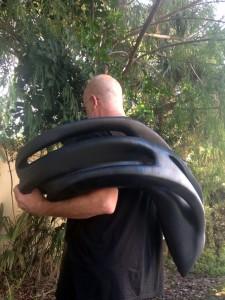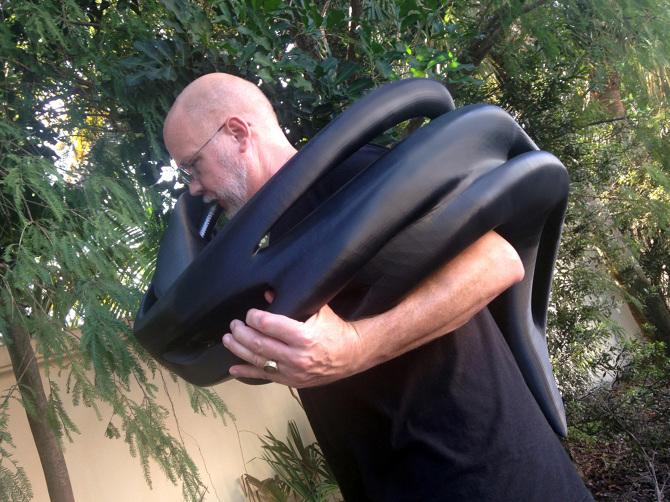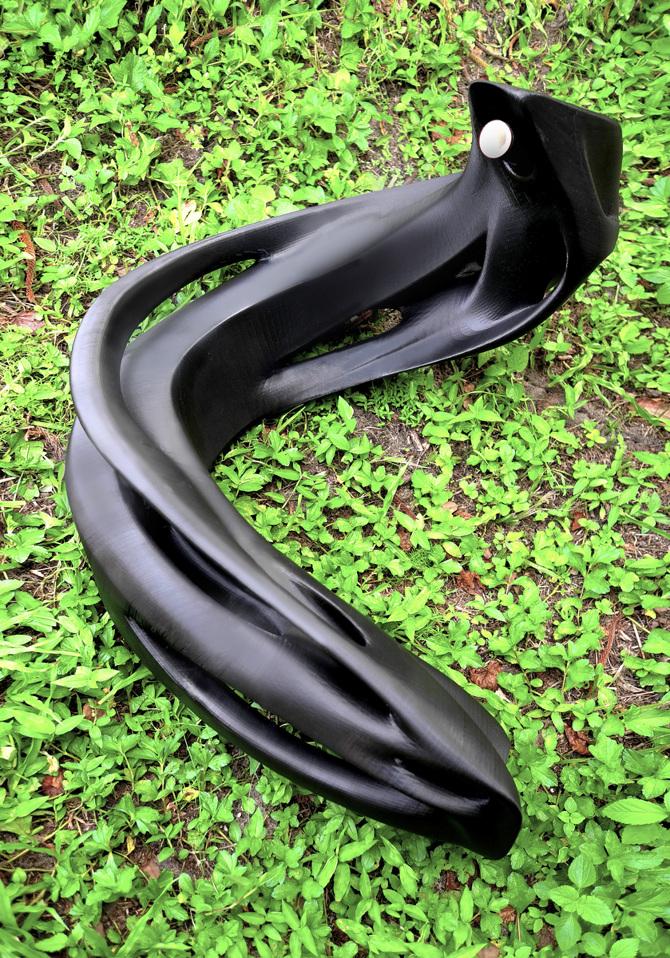MONAD Studio, founded in 2002 by Eric Goldemberg and Veronica Zalcberg, is an architecture firm with a particular interest in exploring the relationships between spatial perception and rhythmic effect. Back in April they made 3D printing headlines with their display of three 3D printed instruments at MecklerMedia‘s 3D Print Week in NY. Those three instruments were the founding trio of a project titled ‘Multi’ to which the studio has now prepared a fourth instrument:  the hornucopian dronepipe. The final instrument that will complete the quintet, a small didgeridoo is still being finished.
the hornucopian dronepipe. The final instrument that will complete the quintet, a small didgeridoo is still being finished.
The wonderfully named hornucopian dronepipe is a brasswind instrument which produces a sound not unlike that of the low, sustained pitches of the didgeridoo. The name drone is given to any instrument or portion of an instrument that produces this type of effect and has been the subject of musical exploration since before written history.
This new take on the drone was created by MONAD in collaboration with musician Scott F. Hall who was introduced to Goldemberg and Zalcberg two years ago. This fortuitous meeting came just as the pair was considering the possibilities for architecture to be pursued at a wider variety of scales than as traditionally practiced. Hall, himself a luthier, has worked with MONAD to express the fundamentals of instrumental performance in entirely novel forms and materials.
Goldemberg worked to explain Hall’s participation in the recreation of these unique instruments:
“Each of the instruments in ‘Multi’ – the monobaribasitar travel bass guitar, violin, cello, didgeridoo, and hornucopia – presents sounds that closely resemble those made by its source ancestor. The pieces’ functionalities in terms of sound generation have been conceived primarily by our musician collaborator, Scott F. Hall, who has a knack for reducing an instrument family down to its barest essentials for the sake of playability.”
 In the hornucopian, the exploration of the ergonomics of the human form and the expression of the instrument is particularly evident. The large instrument sits not on, but around the player, draping over Hall’s body like an anaconda. It has a visual weight to it, and despite being printed in PLA, gives the impression that it would drape slightly and settle in when worn. That close fit between body and instrument is achieved through 3D modeling when combined with expertise in calculating ergonomics and an in depth understanding of the relationship between comfort and correct performance posture.
In the hornucopian, the exploration of the ergonomics of the human form and the expression of the instrument is particularly evident. The large instrument sits not on, but around the player, draping over Hall’s body like an anaconda. It has a visual weight to it, and despite being printed in PLA, gives the impression that it would drape slightly and settle in when worn. That close fit between body and instrument is achieved through 3D modeling when combined with expertise in calculating ergonomics and an in depth understanding of the relationship between comfort and correct performance posture.
 In creating this instrument, a process that took many months, the designers began working with quick pen sketches on whatever material was available when inspiration struck. They then worked to create small models in wood before moving into the digital realm to complete the modeling. Once the pieces were printed, there was a return to working with the physical in order to finish the instrument and make it ready to be played.
In creating this instrument, a process that took many months, the designers began working with quick pen sketches on whatever material was available when inspiration struck. They then worked to create small models in wood before moving into the digital realm to complete the modeling. Once the pieces were printed, there was a return to working with the physical in order to finish the instrument and make it ready to be played.
Goldemberg discussed the impact that the 3D printed material has on their creations:
“Materiality is an interesting point of innovation, because the 3D printers we use produce instruments that are over 80% hollow and filled with an internal honeycomb structure, with multiple small parallel channels only separated by a thin veneer. This creates very interesting internal resonances that give character and unique sound to our instruments.”
Their effort is to 3D print as many of the parts of the instrument as possible and in the hornucopian they have as nearly approached that as possible. As the instrument requires no strings or tuning pegs, it was fabricated entirely by the 3D printer and emerged from the printer nearly ready to play. While the design for the dronepipe took several months, the printing was complete in 10 days and Hall has already recorded a performance and released it on YouTube (check it out above!).
You most likely won’t find yourself humming it while your in the car later, but then you probably weren’t looking for that in a dronepipe. And even if you were never looking for a dronepipe at all, it’s well worth taking the time to give it a listen. Discuss this latest 3D printed piece in the MONAD Studio forum thread on 3DPB.com.
Subscribe to Our Email Newsletter
Stay up-to-date on all the latest news from the 3D printing industry and receive information and offers from third party vendors.
You May Also Like
3D Printing Unpeeled: New Arkema Material for HP, Saddle and Macro MEMS
A new Arkema material for MJF is said to reduce costs per part by up to 25% and have an 85% reusability ratio. HP 3D HR PA 12 S has been...
3D Printing News Briefs, January 20, 2024: FDM, LPBF, Underwater 3D Printer, Racing, & More
We’re starting off with a process certification in today’s 3D Printing News Briefs, and then moving on to research about solute trapping, laser powder bed fusion, and then moving on...
3D Printing Webinar and Event Roundup: December 3, 2023
We’ve got plenty of events and webinars coming up for you this week! Quickparts is having a Manufacturing Roadshow, America Makes is holding a Member Town Hall, Stratafest makes two...
Formnext 2023 Day Three: Slam Dunk
I’m high—high on trade show. I’ve met numerous new faces and reconnected with old friends, creating an absolutely wonderful atmosphere. The excitement is palpable over several emerging developments. The high...
































